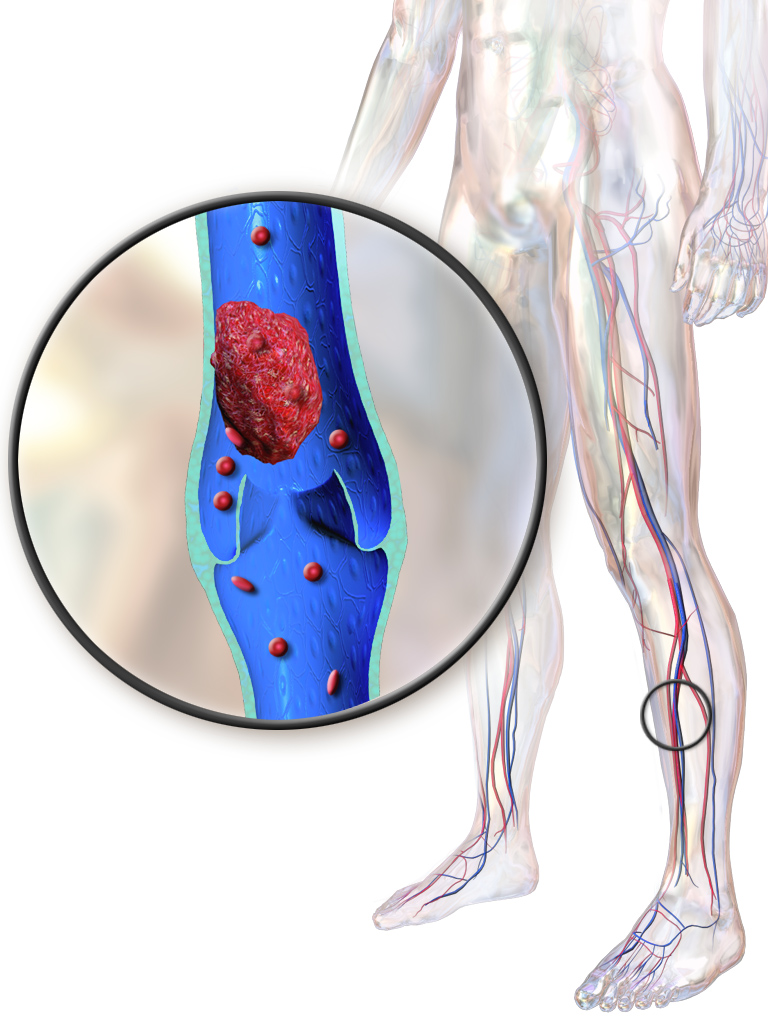DVT in the right leg with swelling and redness[/caption]Deep Vein Thrombosis, also known as DVT, is a blood clot that develops in a deep vein in the body, usually in the large veins in the lower legs and th
![By James Heilman, MD (Own work) [CC BY-SA 3.0 (http://creativecommons.org/licenses/by-sa/3.0) or GFDL (http://www.gnu.org/copyleft/fdl.html)], via Wikimedia Commons](https://upload.wikimedia.org/wikipedia/commons/2/21/Deep_vein_thrombosis_of_the_right_leg.jpg)
DVT in the right leg with swelling and redness
What are the common symptoms of DVT?
- Pain and swelling in the leg, usually the calf. In most cases, only one side is affected.
- Redness and swelling in the affected area.
- Warm skin in the area.
- Tired legs.
- Tenderness in the area when pressure is applied.
In some cases, there may be no symptoms of DVT.
What are the causes of DVT?
Deep vein thrombosis occ

Illustration depicting a deep vein thrombosis
urs for no apparent reason. But the risk of developing DVT increases with:
- Inactivity. When you are inactive, the blood tends to collect in the lower parts of the body, most often the legs. Prolonged periods of inactivity, such as after an illness, injury, or long journey, can cause blood flow to slow down considerably, increasing the chances of blood clot formation.
- Surgery. The risk of getting a clot increases after any surgery that reduces blood flow to the body such as the legs, chest, abdomen, orthopedic surgery such as hip replacement. Also, any surgery that takes longer than 90 minutes also increases the risk. Post-surgical bed confinement that lasts at least three days.
- Blood vessel damage. When blood vessels become damaged or narrowed, this can cause blood clot to form.
- Cancer treatments. Chemotherapy and radiotherapy can increase the risk further.
- Heart disease. People with heart failure have a greater risk of DVT and pulmonary embolism.
- Genetic Conditions. Thrombophilia, a condition where the blood has a tendency to clot, increase DVT risk.
- Pregnancy. The risk for DVT increase 5 to 10 times more frequently in expecting women. However, thromboembolism is not very common, occurring around 1 in every 1000 pregnancies.
Are DVTs dangerous?
The clot or thrombus that is in the leg becomes dangerous if it breaks off or travels through the blood stream, through the heart, and into the pulmonary arteries forming a pulmonary embolism. Because the clot blocks blood flow to the lungs, this can be life-threatening. If undiagnosed and untreated, one in three people with pulmonary embolism won’t survive.
Diagnosing DVT
Although sometimes asymptomatic, most people with deep vein clots experience pain, swelling, and warmth of the leg. This may be worse with standing or walking, and feels better with rest and elevation. When the area is examined there is often severe tenderness with deep pressure, although this could also be found with muscular problems in the same location.
See your doctor as soon as possible if you think you may have DVT. If you experience pain, swelling and a heavy ache in your leg.
The diagnosis and treatment of a deep venous thrombosis (DVT) is meant to prevent life-threatening pulmonary embolism.
Treating DVT

The American College of Chest Physicians-suggested graduated compression stockings for at-risk travelers and some hospital patients
Treatment for DVT usually involves taking anticoagulant medicines. These reduce the blood’s ability to clot and stop existing clots getting bigger.
You’ll also be prescribed compression stockings to wear every day. The special stockings will improve your symptoms and help prevent complications.
For diagnosis and more treatment options, see us at Naples Podiatrist.
——
Serving Southwest Florida Since 2005, Family Foot & Leg Center has 9 convenient locations throughout Collier, Lee, Charlotte, and Sarasota Counties. Offering pediatric to geriatric family care: Ingrown Toenails, Heel Pain, Bunions, Foot / Ankle Arthritis Pain, Plantar Fasciitis, Foot / Ankle Surgery, Custom Orthotics, and Diabetic Wound Care. In office X-rays, ultrasounds, and minor surgical suite exam rooms. Practice powered by EMR and advanced technologies. Home of the Lam Minimal Invasive No-Scar Bunion Surgery! Come Discover Why Patients Love Our 5-Star Foot & Ankle Care! Same Day Appointments! Easy Online Appointment Scheduling!